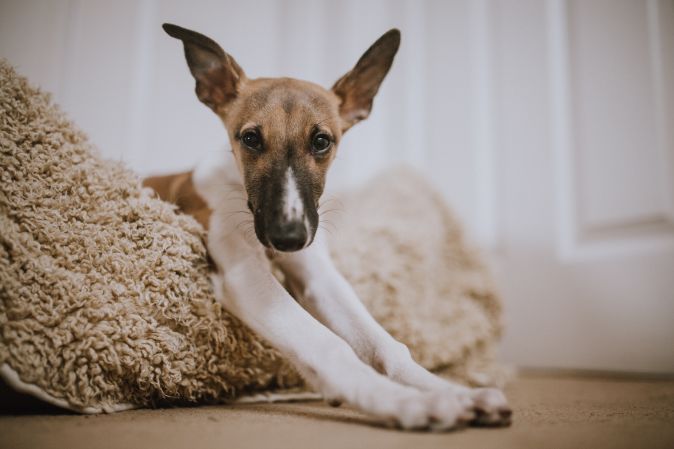
The first time you encounter one of your late pet’s possessions after some time has passed from his or her death, it may be like having a stake driven through your core. It reopens the grief. Whether it’s a chance encounter with a food bowl, a cage, a favorite blanket or toy, the initial feelings of loss can come rushing back.
I get it. Your sweet little rabbit or hamster or dog just passed away. You may be tempted to go through your house immediately and purge everything that reminds you of him or her. For me, it's been things like toys that I find hidden under the couch or another stash of medicines that brings it all flooding back. For my husband, it's as simple as seeing images of our cats around the house.
Worse, well-meaning family and friends may encourage you to give away your pet's things right away in a misguided attempt to remove painful reminders from your world.
But I caution you to slow down - don't rush. Your pet loss pain is real and you need time to work through it.
Take your time and maybe even put off sorting through your pet's possessions until the fresh sting of grief passes. After all, you don't want to rid yourself of something you may wish to have a few weeks, months, or years down the road. Now is not the time to make no-going-back kind of decisions. Take a breath and wait. I'll walk you through how to do this to minimize your pain right now, but protect precious pet keepsakes so that you have them in the future if you want them.
What to Do in the Short Term With Pet's Possessions
In truth, some people would rather trip over the food bowl every day, with the food still in it, and cry, rather than store it in a box or give it away. I'll be honest - that's me. I didn't have the urge to purge after my kitties left me. I wanted to hold on to every little toy and stray bit of fur and took a long time to sort and clean and remove things that reminded me of them. I have known others, however, who are the exact opposite - they need to get rid of every little item that causes pain, and fast. I totally understand. It's hard to have things around that remind you - and I don't want to stoke more the pain by any means. So let's talk about how to work through your animal companions things so you can set them aside to deal with later.
Basically it involves finding ways to avoid the big questions now so that you can answer them later when your brain is less fogged by the mist of grief. Some suggestions for how to put pet belongings out of sight and out of mind ... for now ... include:
- Just Pack It All Away: Get several boxes of the size you need and quickly put everything that belonged to your pet into the boxes and close them up. Don't worry about being too organized or selective. If the items are causing your pain, just do what you need to do to get them out of your sightlines.
- Put Out of Sight: Find a corner of a closet or a part of the garage where you can store these boxes until you're ready to go through them. Be sure the area is safe from water damage or other weathering conditions.
- Store at a Friend's: If having your pet's things in your home - even if out of sight - will cause an emotional weight to hang over you, ask a friend to store your pet's things for a few weeks or month. Use the same site selection criteria as above.
- Set Yourself a Reminder: It's important to not forget about your pet's things. After all, going through them can be very healing - when you're ready. So however you remind yourself of upcoming to-dos, set yourself a task that will ping you in a few weeks or months or a year. This will be especially important if you chose to store your pet's things at someone else's home.
We promise you, it’s going to be OK. You’ve got this.
When Appropriate, Face the Task of Sorting Through Your Pet's Things
It's been a few months or a year... you feel that you’re ready to start sifting through your pet’s belongings, and that means it's time to get yourself organized. This is going to be tough, so fix yourself a warm beverage and grab tissues.
Next, make sure you have a few extra boxes and that you're ready to label them. You're going to sort your pet’s items by the following categories: keep, give-away, and recycle/toss.
Now, here’s where the challenging part begins. It's time to open up those boxes and start to look at things that will bring all those memories back. Take a deep breath and begin when you've got your courage. Then open the first box and start to place each item you remove into one of the sort boxes.
More than likely, your keep box will be fuller than any other box. How do you part with any of it you ask? This is a great place to start as you sort through things. The key is to set a limit before you sort. For example, you might buy a box that can fit in your storage area and only those items that can be stored remain. Or you might set your limit at 10 items. Consider what is reasonable given your storage situation.
Another way to know what's most important to keep and what should be recycled or given away is to ask yourself the following questions:
- Does it have sentimental meaning? A favourite toy, a blanket, ID tags, collars, and things with his or her name may all qualify. These were distinct to your pet or may evokes strong memories which makes them good candidates to save.
- What matters to other family members?: Ask them to go through the items and save what is meaningful to them. You might want to limit keepsakes to one or two per family member.
- Is this something that can be used by another pet?: In particular, large and expensive items like crates, cages, tanks or high-end bedding can be reused with a new animal companion you bring home. But if it's useful and you're unlikely to adopt a new pet in the future, it may make someone else's animal companion very happy and should therefore go in the "give away" box.
Don’t feel you have to accomplish this in one fell swoop. If you feel overwhelmed, stop and come back later whenever you’re ready to start again.
Anythign that is left after you’ve selected the belongings you plan to keep, should go in the "give-away" box or the "recycle/toss" box (see my other post on donating pet possessions).
How to Memorialize Your Pet with His or Her Belongings
Now that you’ve selected which possessions are most meaningful to you and your family, you have some options. The most obvious things to do is to store them somewhere safe and pull them out when you want to remember your pet. But if you want a more regular reminder of your cherished pet, small items can be put into a shadow box with pet pictures to create a memorial piece of art you can display. Pinterest has some sweet ideas for how to remember your pet. But if you have other ideas of how to use pet belongings in meaningful ways, I want to hear them!
It takes time to heal from the grief of losing a pet. Remember, each person’s grief is different. Don't let anyone pressure you to give away or put way your pet's things because “It’s time.” This is your journey and there's no right or wrong way to do it. Going through his or her things, selecting those with the most meaning, and storing them in a way that can allow you to keep their memory close by will help you move through your mourning period, however long that may be.
Image: Nicolas Huk, Mitchel Orr
Affiliate Disclosure: There may be affiliate links on this page which help to pay for Tiny Pet Memories. If you make a purchase through a link I provide, thank you because it may allow me to earn a small commission at no additional cost to you. I am not paid to promote specific products. Any opinions I express are strictly my own.
Health Disclaimer: I’m passionate about wellbeing and health but I’m not a medical professional, nor am I a licensed therapist. Any content you read on this site is intended for inspiration and for information only – by not means am I providing medical advice. Please consult your certified professional for personalized recommendations on the mental health or physical health ideas I write about.

